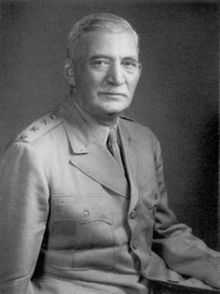William S. Knudsen

William Signius Knudsen (March 25, 1879 – April 27, 1948) was a leading automotive industry executive. His experience and success as a key senior manager in the operations sides of Ford Motor Company and later General Motors led the Franklin Roosevelt Administration to commission him as a Lieutenant General in the United States Army to help lead the United States' war materiel production efforts for World War II.
Background
Knudsen was born in Copenhagen, Denmark. His name was originally Signius Wilhelm Poul Knudsen. He immigrated to the United States arriving in New York in February 1900.
Career
Knudsen was working for the John R. Keim Company of Buffalo, New York when the Ford Motor Company bought it in 1911 for its steel-stamping experience and tooling.[1] Knudsen worked for Ford from 1911[2] to 1921,[3] a decade that saw the formative development of the modern assembly line and true mass production.[4] Working first for the Ford Motor Company and later for General Motors, Knudsen became an expert on mass production and a skilled manager. Knudsen was president of the Chevrolet Division of General Motors from 1924[5] to 1937, and was president of General Motors from 1937[5] to 1940.
In 1940, President Roosevelt, at the recommendation of Bernard Baruch, asked Knudsen to come to Washington to help with war production. Knudsen was appointed as Chairman of the Office of Production Management and member of the National Defense Advisory Commission, for which he received a salary of $1 per year.[6]
In January 1942, Knudsen was commissioned a Lieutenant General in the U.S. Army, the only civilian ever to join the Army at such a high initial rank.[7] and appointed as Director of Production, Office of the Under Secretary of War. In this capacity, he worked as a consultant and a troubleshooter for the War Department.
In both of these positions, Knudsen used his extensive experience in manufacturing and industry respect to facilitate the largest production job in history. In response to the demand for war material, production of machine tools tripled. Total aircraft produced for the US military in 1939 was less than 3,000 planes. By the end of the war, America produced over 300,000 planes. Production of both cargo and Navy ships also increased astronomically. Knudsen's influence not only smoothed government procurement procedures, but also led companies that had never produced military hardware to enter the market. America outproduced its enemies. As Knudsen said, "We won because we smothered the enemy in an avalanche of production, the like of which he had never seen, nor dreamed possible."[8][9][10]
He was appointed Director of the Air Technical Service Command when it was founded in July 1944 at Patterson Field, Ohio. He served in the Army until his resignation on June 1, 1945.
Personal life
Knudsen's son Semon "Bunkie" Knudsen was also a prominent automobile industry executive.
Honors and Awards
Knudsen was awarded the Vermilye Medal by the Franklin Institute in 1941.
Knudsen was awarded the Distinguished Service Medal in 1944 and again in 1945 for his service in the Army during World War II. He also received the American Campaign Medal, and World War Two Victory Medal for his wartime service.
He was also appointed a Knight of the Order of the Dannebrog by the nation of Denmark in 1930 and was promoted Grand Cross of the Order of the Dannebrog in 1946.[11]
Knudsen was inducted into the Automotive Hall of Fame in 1968.
References
- ↑ Hounshell 1984, pp. 224–225.
- ↑ Hounshell 1984, p. 225.
- ↑ Hounshell 1984, p. 264.
- ↑ Hounshell 1984, pp. 217–261.
- ↑ 5.0 5.1 Hounshell 1984, p. 265.
- ↑ Baime, Albert (2014). The Arsenal of Democracy. New York, New York: Houghton Mifflin Harcourt. pp. 72–73. ISBN 978-0-547-71928-3.
- ↑ "Knudsen the Only Civilian To Enter Army at His Rank", The New York Times, January 17, 1942: 9.
- ↑ Herman, Arthur. Freedom's Forge: How American Business Produced Victory in World War II, pp. 3-13, 149, 335-337, Random House, New York, NY, 2012.
- ↑ Parker, Dana. Building Victory: Aircraft Manufacturing in the Los Angeles Area in World War II, pp. 5, 7-10, 13, 59, 131-2., Cypress, CA, 2013.
- ↑ Borth, Christy. Masters of Mass Production, pp. 35-37, 62-93, Bobbs-Merrill Co., Indianapolis, IN, 1945.
- ↑ North American Medal Recipient Index (by William P. Jones. The Order of Dannebrog and other Royal Scandinavian medals. 2009) )
Other sources
- Borth, Christy. Masters of Mass Production (Indianapolis: Bobbs-Merrill Co., 1945).
- Hounshell, David A. (1984), From the American System to Mass Production, 1800-1932: The Development of Manufacturing Technology in the United States, Baltimore, Maryland: Johns Hopkins University Press, ISBN 978-0-8018-2975-8, LCCN 83016269
- Beasley, Norman. Knudsen: a Biography (New York: Whittlesey House, 1947)
- Knudsen, William S. (Current Biography, 1940:464-466)
- Knudsen, William Signius (American National Biographny, 12:843-844)
- William Signius Knudsen (Encyclopedia of American Business History and Biography: The Automobile Industry, 1920-1980. Pages 265-283)
- Herman, Arthur. Freedom's Forge (New York: Random House, 2012).
External links
| Business positions | ||
|---|---|---|
| Preceded by Alfred P. Sloan, Jr. |
President General Motors 1937-1940 |
Succeeded by Charles E. Wilson |